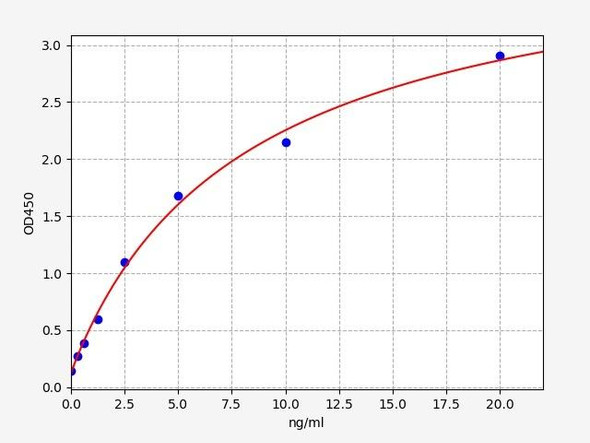Description
Rat Adenosine receptor A2a (Adora2a) ELISA Kit
The Rat Adenosine Receptor A2A (ADORA2A) ELISA Kit is a powerful tool for the quantitative measurement of ADORA2A levels in rat samples, including serum, plasma, and cell culture supernatants. With its high sensitivity and specificity, this kit provides accurate and reliable results for a variety of research applications.ADORA2A is a key receptor involved in the regulation of various physiological processes, including neurotransmission, inflammation, and immune responses.
Dysregulation of ADORA2A has been linked to a range of diseases, making it a valuable target for therapeutic interventions.By using the Rat ADORA2A ELISA Kit, researchers can gain valuable insights into the role of ADORA2A in health and disease, paving the way for the development of novel treatment strategies. Trust in the precision and performance of this kit to advance your research in the field of adenosine receptor biology.
| Product Name: | Rat Adenosine receptor A2a (Adora2a) ELISA Kit |
| SKU: | RTEB0780 |
| Size: | 96T |
| Target: | Rat Adenosine receptor A2a (Adora2a) |
| Synonyms: | Adenosine receptor A2a, Adora2a |
| Assay Type: | Sandwich |
| Detection Method: | ELISA |
| Reactivity: | Rat |
| Detection Range: | 0.312-20ng/mL |
| Sensitivity: | 0.141ng/mL |
| Intra CV: | 3.7% | ||||||||||||||||||||
| Inter CV: | 6.0% | ||||||||||||||||||||
| Linearity: |
| ||||||||||||||||||||
| Recovery: |
| ||||||||||||||||||||
| Function: | Receptor for adenosine. The activity of this receptor is mediated by G proteins which activate adenylyl cyclase. |
| Uniprot: | P30543 |
| Sample Type: | Serum, plasma, tissue homogenates, cell culture supernates and other biological fluids |
| Specificity: | Natural and recombinant rat Adenosine receptor A2a |
| Sub Unit: | Interacts (via cytoplasmic C-terminal domain) with USP4; the interaction is direct. May interact with DRD4. |
| Research Area: | Cancer |
| Subcellular Location: | Cell membrane Multi-pass membrane protein |
| Storage: | Please see kit components below for exact storage details |
| Note: | For research use only |
| UniProt Protein Function: | ADORA2A: one of several receptor subtypes for adenosine. A G-protein coupled receptor. Activation is mediated by G proteins which activate adenylyl cyclase. Abundant in basal ganglia, vasculature and platelets and it is a major target of caffeine. |
| UniProt Protein Details: | Protein type:Receptor, GPCR; Membrane protein, integral; Membrane protein, multi-pass; GPCR, family 1 Cellular Component: asymmetric synapse; axolemma; axon; cell soma; dendrite; endomembrane system; Golgi membrane; integral to membrane; integral to plasma membrane; intermediate filament; membrane; plasma membrane; postsynaptic density; postsynaptic membrane; presynaptic active zone; presynaptic membrane Molecular Function:adenosine receptor activity, G-protein coupled; alpha-actinin binding; enzyme binding; identical protein binding; protein binding; protein heterodimerization activity; type 5 metabotropic glutamate receptor binding Biological Process: adenosine receptor signaling pathway; adenylate cyclase activation; astrocyte activation; eating behavior; G-protein coupled receptor protein signaling pathway; G-protein signaling, adenylate cyclase activating pathway; locomotory behavior; membrane depolarization; negative regulation of alpha-beta T cell activation; negative regulation of caspase activity; negative regulation of cell proliferation; negative regulation of inflammatory response; negative regulation of locomotion; negative regulation of neuron apoptosis; negative regulation of protein kinase activity; negative regulation of vascular permeability; neurite morphogenesis; positive regulation of acetylcholine secretion; positive regulation of cAMP biosynthetic process; positive regulation of circadian sleep/wake cycle, sleep; positive regulation of glutamate secretion; positive regulation of protein secretion; positive regulation of synaptic transmission, GABAergic; positive regulation of synaptic transmission, glutamatergic; prepulse inhibition; protein kinase C activation; regulation of calcium ion transport; regulation of excitatory postsynaptic membrane potential; regulation of inhibitory postsynaptic membrane potential; regulation of mitochondrial membrane potential; regulation of norepinephrine secretion; regulation of synaptic plasticity; regulation of transcription, DNA-dependent; response to alkaloid; response to amphetamine; response to caffeine; response to drug; synaptic transmission, cholinergic; synaptic transmission, dopaminergic; synaptic transmission, glutamatergic; vasodilation |
| NCBI Summary: | plays a role in regulation of blood vessel dilation in the adrenal medulla; regulates sodium excretion [RGD, Feb 2006] |
| UniProt Code: | P30543 |
| NCBI GenInfo Identifier: | 78126172 |
| NCBI Gene ID: | 25369 |
| NCBI Accession: | NP_445746.3 |
| UniProt Related Accession: | P30543 |
| Molecular Weight: | 44,999 Da |
| NCBI Full Name: | adenosine receptor A2a |
| NCBI Synonym Full Names: | adenosine A2a receptor |
| NCBI Official Symbol: | Adora2a |
| NCBI Official Synonym Symbols: | A2ar; ADENO; Adora2l1 |
| NCBI Protein Information: | adenosine receptor A2a |
| UniProt Protein Name: | Adenosine receptor A2a |
| Protein Family: | Adenosine receptor |
| UniProt Gene Name: | Adora2a |
| UniProt Entry Name: | AA2AR_RAT |
| Component | Quantity (96 Assays) | Storage |
| ELISA Microplate (Dismountable) | 8×12 strips | -20°C |
| Lyophilized Standard | 2 | -20°C |
| Sample Diluent | 20ml | -20°C |
| Assay Diluent A | 10mL | -20°C |
| Assay Diluent B | 10mL | -20°C |
| Detection Reagent A | 120µL | -20°C |
| Detection Reagent B | 120µL | -20°C |
| Wash Buffer | 30mL | 4°C |
| Substrate | 10mL | 4°C |
| Stop Solution | 10mL | 4°C |
| Plate Sealer | 5 | - |
Other materials and equipment required:
- Microplate reader with 450 nm wavelength filter
- Multichannel Pipette, Pipette, microcentrifuge tubes and disposable pipette tips
- Incubator
- Deionized or distilled water
- Absorbent paper
- Buffer resevoir
*Note: The below protocol is a sample protocol. Protocols are specific to each batch/lot. For the correct instructions please follow the protocol included in your kit.
Allow all reagents to reach room temperature (Please do not dissolve the reagents at 37°C directly). All the reagents should be mixed thoroughly by gently swirling before pipetting. Avoid foaming. Keep appropriate numbers of strips for 1 experiment and remove extra strips from microtiter plate. Removed strips should be resealed and stored at -20°C until the kits expiry date. Prepare all reagents, working standards and samples as directed in the previous sections. Please predict the concentration before assaying. If values for these are not within the range of the standard curve, users must determine the optimal sample dilutions for their experiments. We recommend running all samples in duplicate.
| Step | |
| 1. | Add Sample: Add 100µL of Standard, Blank, or Sample per well. The blank well is added with Sample diluent. Solutions are added to the bottom of micro ELISA plate well, avoid inside wall touching and foaming as possible. Mix it gently. Cover the plate with sealer we provided. Incubate for 120 minutes at 37°C. |
| 2. | Remove the liquid from each well, don't wash. Add 100µL of Detection Reagent A working solution to each well. Cover with the Plate sealer. Gently tap the plate to ensure thorough mixing. Incubate for 1 hour at 37°C. Note: if Detection Reagent A appears cloudy warm to room temperature until solution is uniform. |
| 3. | Aspirate each well and wash, repeating the process three times. Wash by filling each well with Wash Buffer (approximately 400µL) (a squirt bottle, multi-channel pipette,manifold dispenser or automated washer are needed). Complete removal of liquid at each step is essential. After the last wash, completely remove remaining Wash Buffer by aspirating or decanting. Invert the plate and pat it against thick clean absorbent paper. |
| 4. | Add 100µL of Detection Reagent B working solution to each well. Cover with the Plate sealer. Incubate for 60 minutes at 37°C. |
| 5. | Repeat the wash process for five times as conducted in step 3. |
| 6. | Add 90µL of Substrate Solution to each well. Cover with a new Plate sealer and incubate for 10-20 minutes at 37°C. Protect the plate from light. The reaction time can be shortened or extended according to the actual color change, but this should not exceed more than 30 minutes. When apparent gradient appears in standard wells, user should terminatethe reaction. |
| 7. | Add 50µL of Stop Solution to each well. If color change does not appear uniform, gently tap the plate to ensure thorough mixing. |
| 8. | Determine the optical density (OD value) of each well at once, using a micro-plate reader set to 450 nm. User should open the micro-plate reader in advance, preheat the instrument, and set the testing parameters. |
| 9. | After experiment, store all reagents according to the specified storage temperature respectively until their expiry. |
When carrying out an ELISA assay it is important to prepare your samples in order to achieve the best possible results. Below we have a list of procedures for the preparation of samples for different sample types.
| Sample Type | Protocol |
| Serum | If using serum separator tubes, allow samples to clot for 30 minutes at room temperature. Centrifuge for 10 minutes at 1,000x g. Collect the serum fraction and assay promptly or aliquot and store the samples at -80°C. Avoid multiple freeze-thaw cycles. If serum separator tubes are not being used, allow samples to clot overnight at 2-8°C. Centrifuge for 10 minutes at 1,000x g. Remove serum and assay promptly or aliquot and store the samples at -80°C. Avoid multiple freeze-thaw cycles. |
| Plasma | Collect plasma using EDTA or heparin as an anticoagulant. Centrifuge samples at 4°C for 15 mins at 1000 × g within 30 mins of collection. Collect the plasma fraction and assay promptly or aliquot and store the samples at -80°C. Avoid multiple freeze-thaw cycles. Note: Over haemolysed samples are not suitable for use with this kit. |
| Urine & Cerebrospinal Fluid | Collect the urine (mid-stream) in a sterile container, centrifuge for 20 mins at 2000-3000 rpm. Remove supernatant and assay immediately. If any precipitation is detected, repeat the centrifugation step. A similar protocol can be used for cerebrospinal fluid. |
| Cell culture supernatant | Collect the cell culture media by pipette, followed by centrifugation at 4°C for 20 mins at 1500 rpm. Collect the clear supernatant and assay immediately. |
| Cell lysates | Solubilize cells in lysis buffer and allow to sit on ice for 30 minutes. Centrifuge tubes at 14,000 x g for 5 minutes to remove insoluble material. Aliquot the supernatant into a new tube and discard the remaining whole cell extract. Quantify total protein concentration using a total protein assay. Assay immediately or aliquot and store at ≤ -20 °C. |
| Tissue homogenates | The preparation of tissue homogenates will vary depending upon tissue type. Rinse tissue with 1X PBS to remove excess blood & homogenize in 20ml of 1X PBS (including protease inhibitors) and store overnight at ≤ -20°C. Two freeze-thaw cycles are required to break the cell membranes. To further disrupt the cell membranes you can sonicate the samples. Centrifuge homogenates for 5 mins at 5000xg. Remove the supernatant and assay immediately or aliquot and store at -20°C or -80°C. |
| Tissue lysates | Rinse tissue with PBS, cut into 1-2 mm pieces, and homogenize with a tissue homogenizer in PBS. Add an equal volume of RIPA buffer containing protease inhibitors and lyse tissues at room temperature for 30 minutes with gentle agitation. Centrifuge to remove debris. Quantify total protein concentration using a total protein assay. Assay immediately or aliquot and store at ≤ -20 °C. |
| Breast Milk | Collect milk samples and centrifuge at 10,000 x g for 60 min at 4°C. Aliquot the supernatant and assay. For long term use, store samples at -80°C. Minimize freeze/thaw cycles. |








